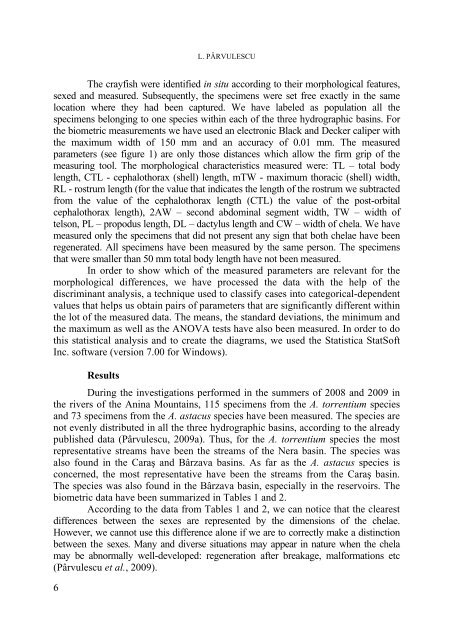biologia - Studia
biologia - Studia
biologia - Studia
You also want an ePaper? Increase the reach of your titles
YUMPU automatically turns print PDFs into web optimized ePapers that Google loves.
L. PÂRVULESCU<br />
The crayfish were identified in situ according to their morphological features,<br />
sexed and measured. Subsequently, the specimens were set free exactly in the same<br />
location where they had been captured. We have labeled as population all the<br />
specimens belonging to one species within each of the three hydrographic basins. For<br />
the biometric measurements we have used an electronic Black and Decker caliper with<br />
the maximum width of 150 mm and an accuracy of 0.01 mm. The measured<br />
parameters (see figure 1) are only those distances which allow the firm grip of the<br />
measuring tool. The morphological characteristics measured were: TL – total body<br />
length, CTL - cephalothorax (shell) length, mTW - maximum thoracic (shell) width,<br />
RL - rostrum length (for the value that indicates the length of the rostrum we subtracted<br />
from the value of the cephalothorax length (CTL) the value of the post-orbital<br />
cephalothorax length), 2AW – second abdominal segment width, TW – width of<br />
telson, PL – propodus length, DL – dactylus length and CW – width of chela. We have<br />
measured only the specimens that did not present any sign that both chelae have been<br />
regenerated. All specimens have been measured by the same person. The specimens<br />
that were smaller than 50 mm total body length have not been measured.<br />
In order to show which of the measured parameters are relevant for the<br />
morphological differences, we have processed the data with the help of the<br />
discriminant analysis, a technique used to classify cases into categorical-dependent<br />
values that helps us obtain pairs of parameters that are significantly different within<br />
the lot of the measured data. The means, the standard deviations, the minimum and<br />
the maximum as well as the ANOVA tests have also been measured. In order to do<br />
this statistical analysis and to create the diagrams, we used the Statistica StatSoft<br />
Inc. software (version 7.00 for Windows).<br />
6<br />
Results<br />
During the investigations performed in the summers of 2008 and 2009 in<br />
the rivers of the Anina Mountains, 115 specimens from the A. torrentium species<br />
and 73 specimens from the A. astacus species have been measured. The species are<br />
not evenly distributed in all the three hydrographic basins, according to the already<br />
published data (Pârvulescu, 2009a). Thus, for the A. torrentium species the most<br />
representative streams have been the streams of the Nera basin. The species was<br />
also found in the Caraş and Bârzava basins. As far as the A. astacus species is<br />
concerned, the most representative have been the streams from the Caraş basin.<br />
The species was also found in the Bârzava basin, especially in the reservoirs. The<br />
biometric data have been summarized in Tables 1 and 2.<br />
According to the data from Tables 1 and 2, we can notice that the clearest<br />
differences between the sexes are represented by the dimensions of the chelae.<br />
However, we cannot use this difference alone if we are to correctly make a distinction<br />
between the sexes. Many and diverse situations may appear in nature when the chela<br />
may be abnormally well-developed: regeneration after breakage, malformations etc<br />
(Pârvulescu et al., 2009).
















